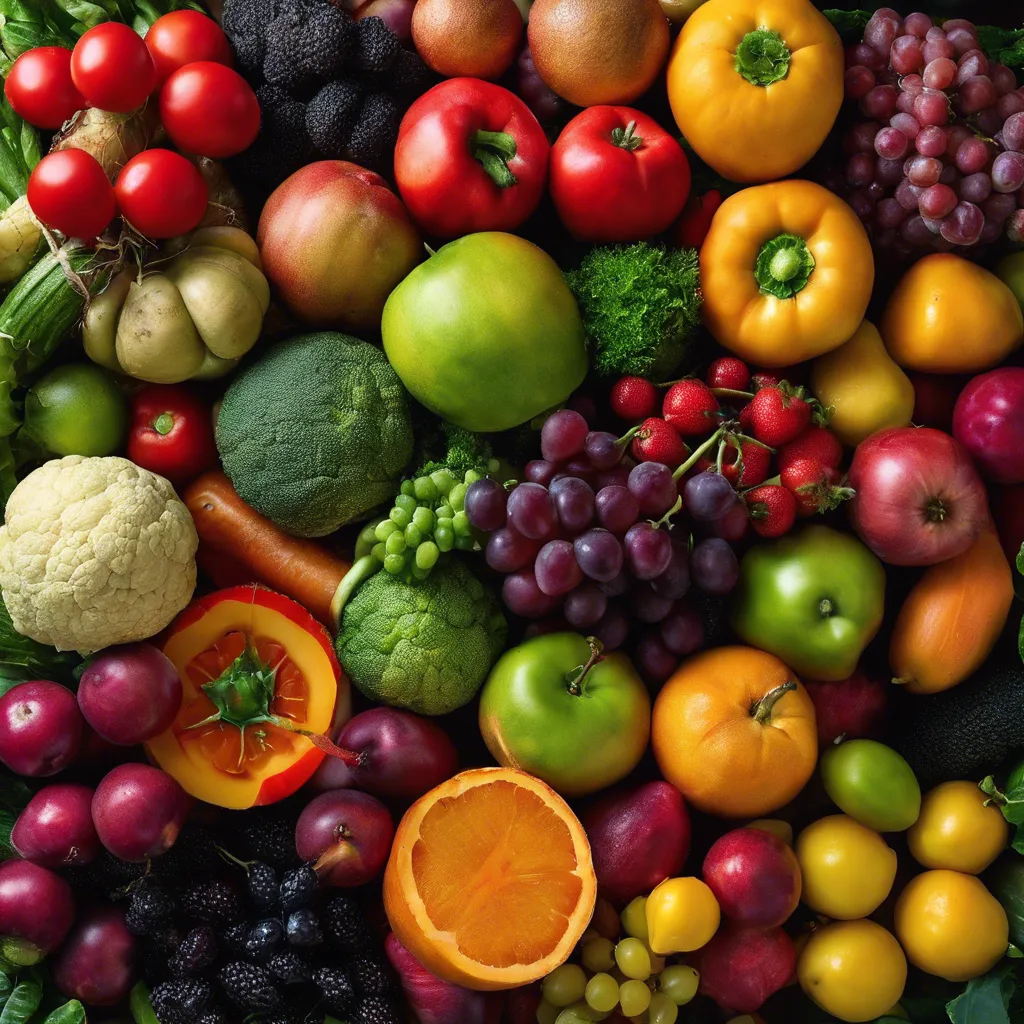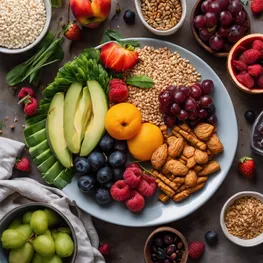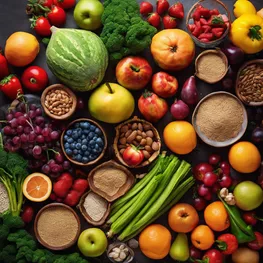Table of contents
- Unraveling the Glycemic Index: Facts and Benefits
- Managing Blood Sugar Levels with the Glycemic Index
- How to Make Better Food Choices for Blood Sugar Control
- Achieve Optimal Blood Sugar Control with Low GI Foods
- 10 More Tips for Managing Blood Sugar Levels
In the quest for healthy living, understanding the glycemic index is a crucial tool for natural blood sugar control. This article explores what the glycemic index is and how it can help maintain stable blood sugar levels. Discover the impact of different foods on glucose levels and empower yourself with knowledge to make informed dietary choices. Say goodbye to spikes and crashes as you gain mastery over your blood sugar levels.
Unraveling the Glycemic Index: Facts and Benefits
The Glycemic Index (GI) is a ranking system that measures how carbohydrates in food affect blood glucose levels. It assigns a value to each food, indicating how quickly it raises blood sugar levels. Foods with a high GI are digested rapidly, leading to a rapid surge and crash in blood sugar levels. On the other hand, foods with a low GI are digested slowly, providing a steady release of glucose into the bloodstream. Maintaining a low GI diet has several benefits, including better blood sugar control, sustained energy levels, and improved weight management.
Managing Blood Sugar Levels with the Glycemic Index
Managing Blood Sugar Levels with the Glycemic Index
- Understand the Glycemic Index (GI) scale: The Glycemic Index is a measurement system that ranks carbohydrates based on how quickly and how much they raise blood sugar levels. Foods with a high GI are quickly digested and cause a rapid rise in blood sugar, while low GI foods are digested more slowly and have a slower impact on blood sugar.
- Choose low GI foods: Opt for foods that have a low GI value (55 or less) as they have a lesser impact on blood sugar levels. These include whole grains, vegetables, legumes, and most fruits.
- Avoid high GI foods: High GI foods (GI value of 70 or more) should be consumed in moderation or avoided. These foods include processed grains, sugary snacks, sugar-sweetened beverages, and certain fruits like watermelon and pineapple.
- Combine high GI foods with low GI foods: If you want to eat high GI foods, try to balance them with low GI foods. For example, pair a high GI food like white rice with vegetables or lean protein to slow down its impact on blood sugar.
- Consider the glycemic load: The glycemic load (GL) takes into account both the GI and the portion size of a food. It provides a more accurate measure of how a food affects blood sugar levels. Foods with a low glycemic load have a minimal impact on blood sugar.
- Read food labels: Look for the GI information on food labels or use online resources to determine the GI value of different foods. This can help you make informed choices when grocery shopping.
- Consult a healthcare professional: If you have diabetes or are concerned about managing your blood sugar levels, consult a healthcare professional or a registered dietitian for personalized advice on using the glycemic index to make healthier food choices.
How to Make Better Food Choices for Blood Sugar Control
Maintaining stable blood sugar levels is essential for overall health. One way to achieve this is by making better food choices. Certain high glycemic index foods can cause a rapid spike in blood sugar levels, which is not ideal for individuals who need to control their blood sugar. Here are some examples of such foods:
-
White Bread
White bread has a high glycemic index due to its refined grains. It is quickly broken down into glucose, leading to a sharp increase in blood sugar levels.
-
Soft Drinks
Soft drinks, especially those with added sugar, are filled with simple carbohydrates and can quickly raise blood glucose levels. Consuming them in excess can lead to insulin resistance.
-
Potatoes
Potatoes, especially when cooked and mashed, have a high glycemic index. They are rich in starch, which is rapidly converted to sugar in the body, causing a spike in blood sugar levels.
-
Processed Snacks
Processed snacks like chips, cookies, and cakes often contain refined flour, sugar, and unhealthy fats. These ingredients contribute to a high glycemic load and can cause blood sugar levels to rise rapidly.
-
Sweetened Breakfast Cereals
Many breakfast cereals marketed as healthy options are loaded with sugar. These cereals have a high glycemic index and can cause a sudden increase in blood sugar levels, especially when consumed in large quantities.
Achieve Optimal Blood Sugar Control with Low GI Foods
Maintaining stable blood sugar levels is essential for achieving optimal blood sugar control. One effective strategy is to incorporate low glycemic index (GI) foods into your diet. These foods have a lower impact on blood sugar levels, as they are digested and absorbed more slowly. By choosing low GI foods, you can help prevent spikes and crashes in your blood sugar, promoting a steady and balanced energy throughout the day. Here are some examples of low GI foods that you can include in your diet:
-
1. Whole Grains
Whole grains like oats, quinoa, and brown rice have a lower GI compared to refined grains. They provide a slow release of glucose, keeping blood sugar levels stable.
-
2. Legumes
Legumes, such as chickpeas, lentils, and black beans, are excellent sources of protein and fiber. They have a low GI and can help regulate blood sugar levels.
-
3. Non-Starchy Vegetables
Non-starchy vegetables like broccoli, spinach, and kale are packed with nutrients and have a minimal impact on blood sugar. They are low in calories and high in fiber.
-
4. Nuts and Seeds
Nuts and seeds, such as almonds, walnuts, and chia seeds, are rich in healthy fats, protein, and fiber. They have a low GI and can help maintain steady blood sugar levels.
-
5. Berries
Berries, including strawberries, blueberries, and raspberries, are low in carbohydrates and high in antioxidants. They have a low GI and provide essential vitamins and minerals.
10 More Tips for Managing Blood Sugar Levels
Maintaining blood sugar levels is crucial for overall health. In addition to following a low GI diet, there are several lifestyle changes and habits that can complement your efforts. Here are 10 more tips for managing blood sugar levels:
-
Engage in Regular Physical Activity
Exercise helps to improve insulin sensitivity and promotes the use of glucose by the muscles, which can help regulate blood sugar levels.
-
Stay Hydrated
Drinking plenty of water helps prevent dehydration, which can affect blood sugar levels. It also aids in digestion and helps maintain overall health.
-
Manage Stress Levels
Chronic stress can raise blood sugar levels. Engaging in stress management techniques such as meditation, deep breathing exercises, or engaging in hobbies can be beneficial.
-
Get Enough Quality Sleep
Lack of sleep can affect insulin sensitivity and lead to elevated blood sugar levels. Aim to get 7-9 hours of quality sleep per night.
-
Practice Portion Control
Controlling portion sizes helps regulate carbohydrate intake, which in turn helps manage blood sugar levels. Use smaller plates and be mindful of portion sizes.
-
Choose Whole Grains and Fiber-Rich Foods
Whole grains and fiber-rich foods have a lower glycemic index, which means they cause a slower rise in blood sugar levels. Incorporate foods like brown rice, quinoa, and fruits and vegetables into your diet.
-
Include Lean Proteins in Meals
Including lean proteins like chicken, fish, tofu, or beans in your meals helps regulate blood sugar levels. Proteins slow down the digestion and absorption of carbohydrates, preventing rapid spikes in blood sugar.
-
Limit Processed Foods and Sugary Drinks
Processed foods and sugary drinks often contain high amounts of added sugars and refined carbohydrates, which can cause blood sugar to spike. Opt for whole, unprocessed foods and choose water or unsweetened beverages instead.
-
Avoid Skipping Meals
Skipping meals can lead to unstable blood sugar levels. Eat regular, balanced meals throughout the day to maintain a stable blood sugar level.
-
Monitor Blood Sugar Levels Regularly
Regularly monitoring your blood sugar levels can help you understand how different foods and habits affect your body. It allows you to make necessary adjustments to your diet and lifestyle to keep your blood sugar within a healthy range.
In conclusion, the glycemic index is a valuable tool for maintaining natural blood sugar control. By understanding how different foods affect our blood sugar levels, we can make informed choices to manage and prevent conditions such as diabetes. Incorporating low-glycemic foods into our diet can help stabilize blood sugar, providing sustained energy and reducing the risk of chronic diseases. By utilizing this tool, individuals can take proactive steps towards achieving optimal health and well-being.
Frequently asked questions related to understanding the glycemic index
What is the Glycemic Index?
The Glycemic Index (GI) is a ranking system for carbohydrates based on their effect on blood glucose levels.
How does the Glycemic Index work?
Foods with a high GI are digested quickly, causing a rapid rise in blood sugar levels. Foods with a low GI are digested more slowly, resulting in a gradual and steady release of glucose into the bloodstream.
Which foods have a low Glycemic Index?
Foods that are rich in fiber and whole grains, such as fruits, vegetables, legumes, and whole wheat products, typically have a lower GI.
How can I use the Glycemic Index to make healthier food choices?
When planning meals, aim to include a variety of low GI foods, such as whole grains, lean proteins, and healthy fats. Limit your consumption of high GI foods, or pair them with low GI foods to balance out the overall GI of the meal.
Why is the Glycemic Index important for natural blood sugar control?
By choosing foods with a lower GI, you can help stabilize your blood sugar levels and prevent spikes and crashes. This can be especially beneficial for individuals with diabetes or those looking to manage their weight.
Is the Glycemic Index suitable for everyone?
While the GI can be a helpful tool for blood sugar control, it may not be necessary or applicable for everyone. Individuals with specific medical conditions or dietary restrictions should consult with a healthcare professional before making any major changes to their diet based on the GI.
Are there any limitations to the Glycemic Index?
The GI can vary depending on factors such as cooking method, ripeness of fruit, and presence of other macronutrients. It should be used as a guide rather than a strict rule.
Which foods have a high Glycemic Index?
Foods that are high in refined carbohydrates, such as white bread, white rice, and sugary snacks, tend to have a high GI.







